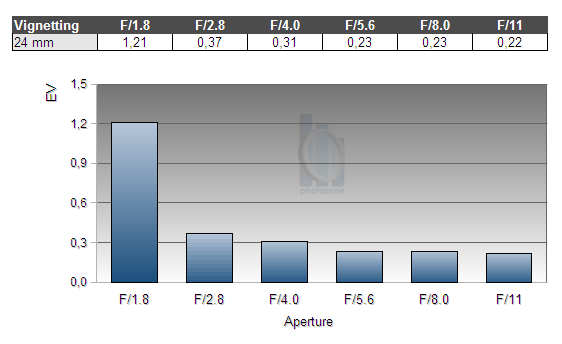|
Page 2 of 2

Distortion
On a DX camera, the lens produces a small amount of barrel distortion of 0.9%.

Vignetting
Lenses designed for the bigger FX sensor area usually take advantage of the reduced sensor size of DX cameras when it comes to vignetting. However, the Nikkor showed a huge amount of vignetting wide open in our FX review, so it's not surprising that on DX the amount of light fall-off at the largest aperture setting is also relatively high.
As usual, however, stopping down reduces the amount of vignetting, at f/2.8 already the remaining amount should not be an issue anymore for most subjects.

MTF (resolution)
On the D7200, the Nikkor shows very good resolution in the image center at f/1.8, improving to excellent figures when stopped down.
The borders and corners are very good straight from the maximum aperture, too. Surprisingly, they don't improve very much by stopping down.
The lens showed a tiny amount of focus shifting when stopping down (residual spherical aberration), not to a degree that it is field-relevant, though.
Please note that the MTF results are not directly comparable across the different systems!
Below is a simplified summary of the formal findings. The chart shows line widths per picture height (LW/PH) which can be taken as a measure for sharpness.
If you want to know more about the MTF50 figures you may check out the corresponding Imatest Explanations

Chromatic Aberrations (CAs)
Chromatic aberrations (color shadows at harsh contrast transitions) are well controlled, with values of roughly 0.5 to 0.6 pixels on average at the image borders throughout the tested aperture range.

Bokeh
It's usually not the primary way to use a wide angle lens, however the Nikkor has a comparatively short minimal focus distance combined with a fairly large maximum aperture, so it allows to separate a (close) main subject from the background. In such a shot, the quality of image blur in out-of-focus areas is important.
Typically, wide angle lenses with aspherical elements struggle in this regard, the Nikkor however delivers very pleasing results. General image blur both in front of as well as behind the focal plane is surprisingly smooth.
Background highlights are evenly filled and show almost no outlining wide open, a little more so when stopped down, however. In addition, there are traces of bokeh fringing around highlights (see the next section)

Bokeh Fringing
Bokeh fringing (non-coinciding focal planes of the various colors) is a common issue with relatively fast glass. As you can notice below the halos have different colors - magenta (red + blue) in front of the focus point and green beyond. Unlike lateral lateral CAs, bokeh fringing can not easily be fixed in post processing.
Typical for most fast primes the Nikkor shows some bokeh fringing at large aperture settings. The fringing can be reduced by stopping down and it's mostly gone from f/4 onward.
In addition, these shots also illustrate the tiny amount of focus shift when stopping down that was mentioned in the MTF section.
|
Move the mouse cursor over the f-stop marks below to observe the respective LoCAs
|
| f/1.8 |
f/2.8 |
f/4 |
f/5.6 |
f/8 |
|

|
Sample Images
You can find some sample images taken with the Nikon D3x in our Nikon FX review of the lens.
Verdict
The Nikkor delivers impressive resolution across the image frame straight from the maximum aperture. CA's are well controlled and image distortion is moderate. In addition, the bokeh quality of the lens is on a surprisingly high level for such a wide angle lens.
The Nikkor is not without flaws, though. Vignetting at the largest aperture is quite pronounced for a FX lens on a DX camera. In summary, however, the lens performs very well.
Build quality is on the same level as the other f/1.8 Nikkor lenses, high quality plastic that does not give the impression of handling a luxury item but does its job. This lens feels lightweight, but not fragile.
Thanks to an AF-S drive, the Nikkor is compatible with all current DSLRs (entry level DX included) and autofocus speed is silent and quite fast.
Given its good performance, the current retail price of around 750 EUR is acceptable. At this price point, however, it competes with Sigma's 24mm f/1.4 Art lens, which does not offer the same level of sharpness, but even more creative potential with its faster f/1.4 aperture. But it's also bigger and heavier. When choosing between these two, it comes down to personal priorities to decide which one to pick.
|